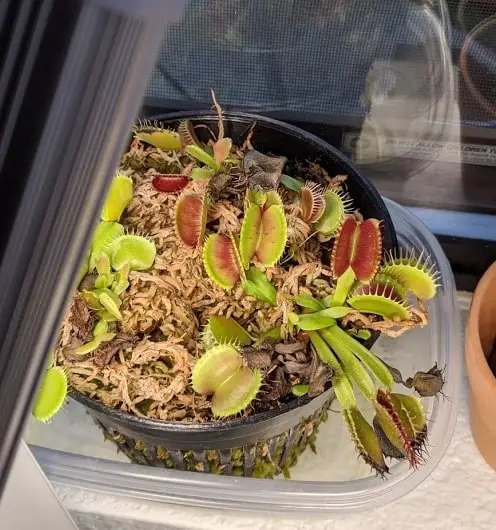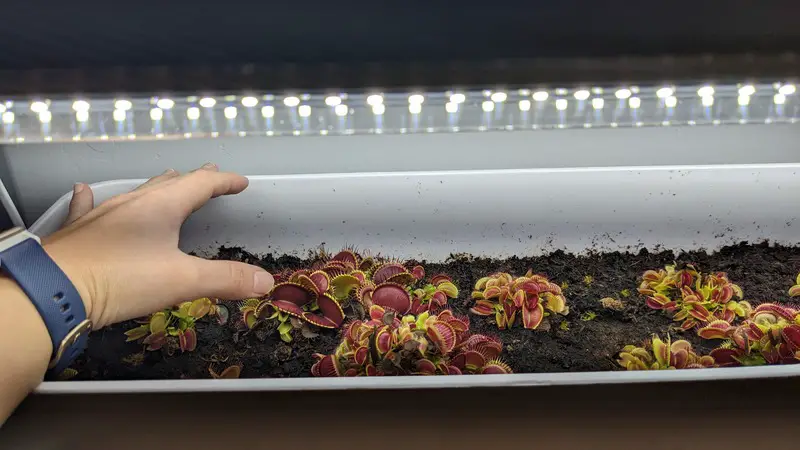Venus fly traps need a lot of light to grow. Sunlight is the best light source for fly traps; however, not all can provide long hours of daily sunlight to this unique plant. I have grown Venus flytraps indoors successfully with artificial lights, and I will teach you how you can do the same.
When employing artificial lights for Venus fly traps, choose LED or fluorescent bulbs of at least 1500 lumens. The preferred temperature is 6500K. Place the artificial lights 10-12 inches from the Venus fly traps and run the lights for 10-16 hours a day.
Growing Venus Fly Traps Indoors vs. Outdoor?
Because Venus fly traps need a lot of lighting to grow and be healthy, sunlight is the best light source. If you have the possibility of growing your fly trap outdoors and providing at least 4-6 hours of direct sunlight, choose the outdoor option. If you can’t provide a sunny outdoor location for your plant, then choose indoor growing with artificial lights or a combination of natural and artificial lighting.
For a complete overview of lighting for Venus flytraps, read my full guide in this article .
.
The Best Artificial Lights for Venus Flytraps
Venus fly traps require powerful lighting. You will need to look for bulbs or light fixtures that provide at least 1500 lumens. Then, you will need to keep those lights on for 10-16 hours a day. This table summarizes the spec to look for suitable lights for Venus flytraps. Also, you can check out my recommendations below.
| Technology Type | LED or fluorescent lights |
| Color | 6500K (cool white) |
| Lumens | >1400 lumens |
| Daily Timer | 12h or more would be optimal. Some lights come with built-in timers |
Personally, I have used these different types of lighting successfully. Each of them adapts to different setups:
Cheapest Artificial Lights for Venus Flytraps
The cheapest lights for Venus flytraps are T8 fluorescent lights or single Compact Fluorescent Light (CFL) bulbs. I recommend the T8 tubes for multiple plants and the single bulbs for single plants. Here is a direct link for the compact light bulbs: CFL, 6500K, 2100 lumens .
.
The unit price for this option is about $10-13, but keep in mind that you will need a lamp or a socket to mount it too.
Practical Artificial Light Fixture for 2-3 Venus Fly Traps

When I first started growing Venus flytraps, I only had three in a single pot. These lights have helped me provide appropriate lighting for them for over a year. Eventually, I switched to a larger lighting setup, but this light is perfect if you are just getting started or just have a few plants.
have helped me provide appropriate lighting for them for over a year. Eventually, I switched to a larger lighting setup, but this light is perfect if you are just getting started or just have a few plants.
The light comes with time to set up the lighting cycle. I recommend choosing the 12-hour cycle. Place your plants 5-10 inches away from the light to maximize exposure, and make sure all the bulbs are pointing directly at your plants.
The Best Artificial Lights for Multiple Venus Flytraps

Once your collection of Venus flytraps or carnivorous plants grows, you will need a powerful and large setup with lights. Here is a link to the LED lights I use so you can check the price and reviews .
.
These LED light fixtures are some of my favorites for a few reasons:
– They provide enough lumens for Venus flytraps when placed directly over the plant (5-10 inches away)
– They do not get hot and can be placed close to plants without burning
– They are energy efficient
To install these LED tube lights, I suggest using a plant shelf. It is a solid way to get organized, and you can connect multiple lights to each other to provide even more lighting to your Venus fly trap.
You will also need a timer to manage to turn the power on and off for these fixtures. You can get a smart outlet like this one and run the lights daily for 12 to 16 hours.
LED vs. Fluorescent Lights for Venus Fly traps
LEDs and fluorescent lights are both suitable for Venus flytraps and most carnivorous plants. However, there are some benefits why I prefer LEDs over fluorescent alternatives.
LEDs are much more energy efficient than fluorescent lights. When you have a lot of lights, all running for over 12 hours a day. Efficiency is critical.
It is critical that you keep the light source close to your plants. LEDs do not overheat, so you can place them very close to your plant without risking burning them.
Still, fluorescent lights are a viable option. Do not be afraid to use them if you have some in hand. Also, they are cheaper alternatives to start with, even though the energy bill will be higher.
How To Build An Indoor Setup for Your Venus Flytrap
Follow this section step by step to set artificial lights and your Venus flytraps in the appropriate environment.
1- Find the right place for your Venus flytrap.
Find a spot where your Venus fly trap can grow without stress. Consider that pets are usually curious about Venus fly traps and might like playing with them. I recommend a place that keeps the plants away from pets, and that has access to natural light.
Even if you know you will need artificial lights, look for a place where your plant has access to some sunlight to supplement its growth.
2- Select the artificial lights for your Venus flytrap
Use LED or fluorescent lights that provide at least 1500 lumens at 6500K.
3- Mount the artificial lights directly over your Venus fly trap
Mount the lights 5-10 inches away from your plant. Depending on the lumens your plant receives, you might be able to either move the lights farther away or bring them closer together.
4- Set up the light timer
Since artificial lights are not as powerful as sunlight, you must have them on for extended periods of time. Set the timer to turn on your lights for at least 12 hours. In my current setup, I run them for 14 hours.
5- Adjust the lighting distance
As your plants adapt to the new lighting, you should monitor them to determine if they are happy with the lighting or if they might require more. Usually, plants take 2-4 weeks to show signs the light might not be enough.
This next chapter outlines some clear signs your Venus fly traps need light.
8 Signs Your Venus Fly Trap Doesn’t Receive Enough Light
When Venus fly traps do not receive enough light, they suffer greatly and start exhibiting signs. Here are some to keep an eye on:
- Your Venus flytrap is losing its colors
- The petioles are growing wide
- Venus fly traps are not producing traps
- The plant is droopy and wilting
- The traps have lost all red coloring
- The traps stop working; they won’t close
- The plant is losing leaves and reducing in size
This article covers each of these signs and outlines how to fix these problems: 7 signs your Venus flytrap needs more light .
.
Venus Fly Trap Indoor Care Tips
Growing Venus flytraps indoors can be quite challenging, there are several considerations to be aware of when growing Venus fly traps inside your home:
Lighting: Provide at least 12 hours of artificial lighting and, if possible, supplement with direct or indirect sunlight from a window sill or a glass door
Watering: Water Venus fly traps often to keep the soil always humid but not flooded. When growing indoors, avoid overwatering and leaving the soil soggy for extended periods of time. Overwatering can cause root rot and mold issues.
Feeding: IndoorsVenus flytraps will have little to no access to bugs. Employ a single insect to feed your Venus flytrap once every 1-2 months to encourage growth.
Dormancy: Venus flytraps need a period of inactivity called dormancy every single year. In order to go dormant, they need to experience cold temperatures for 3-4 months. The temperatures must be lower than 45F. When growing Venus flytraps indoors in a heated location, consider moving your Venus fly traps outdoors or to an unheated location so they can experience winter and dormancy. Dormancy is critical to keep your plant alive in the long term.
Terrariums: Avoid growing Venus fly traps in terrariums. Closed terrariums do not provide enough air circulation and can cause many issues.

